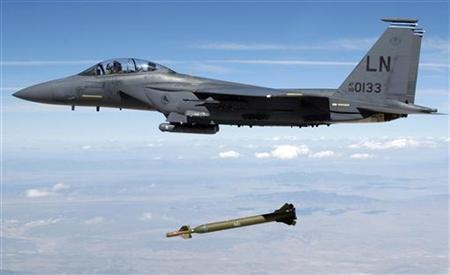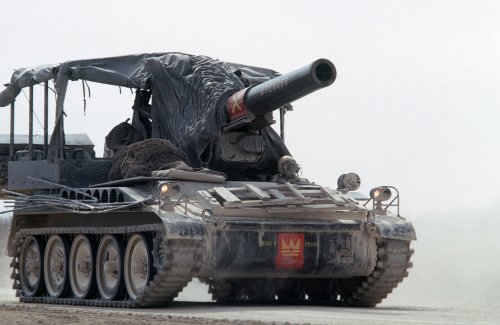You are using an out of date browser. It may not display this or other websites correctly.
You should upgrade or use an alternative browser.
You should upgrade or use an alternative browser.
GBU-28 Development History
- Thread starter fredymac
- Start date
- Joined
- 3 June 2006
- Messages
- 3,094
- Reaction score
- 3,963
Thanks for this video!
I remember well, when I as a teenager in the mid-90's read this development history in the book 'Tom Clancy – Fighter Wing – A Guided Tour of an Air Force Combat Wing'.
I remember well, when I as a teenager in the mid-90's read this development history in the book 'Tom Clancy – Fighter Wing – A Guided Tour of an Air Force Combat Wing'.
Found another historical video with a more comprehensive overview on the development effort.
View: https://www.youtube.com/watch?v=fIVA2RLZHvY
- Joined
- 9 October 2009
- Messages
- 21,973
- Reaction score
- 13,624
Should this be moved over to Missile Projects?
- Joined
- 3 June 2011
- Messages
- 18,335
- Reaction score
- 12,235
The thing about this project that always amused me is the guy saying, "I know where there's a field of howitzer barrels. . ." (The original barrels removed from the M110s when they put the new ones on.) Really puts a spotlight on the importance have having the right people talking to each other, and also not throwing stuff away that might be useful down the road.
Attachments
- Joined
- 26 May 2011
- Messages
- 2,318
- Reaction score
- 3,472
I've been looking at Paveway recently and (OK, OK, yes, yes, it's Wiki) on the Wiki page for the GBU-28 it says:
'It proved capable of penetrating over 50 metres (164ft) of earth or 5 metres (16ft) of solid concrete'
Donning my Geologist's (hard) hat - what is 'earth'?
Chris
'It proved capable of penetrating over 50 metres (164ft) of earth or 5 metres (16ft) of solid concrete'
Donning my Geologist's (hard) hat - what is 'earth'?
Chris
The video is private.
- Joined
- 6 November 2010
- Messages
- 5,262
- Reaction score
- 5,514
Harry Harrison at one time lets one of his protagonists - professor Coypu - refer to mankind's legendary home as 'Dirt or Earth or something like that' (The Stainless Steel Rat saves The World). 'Blown up in an atomic war ages ago'.Maybe it's a translation from German language ?
Here "Erde" (earth) means our planet, as well as that usually dark, dirty and
somehow crumbly substance, you call "soil"
Last edited:
- Joined
- 26 May 2011
- Messages
- 2,318
- Reaction score
- 3,472
That's my understanding of 'earth' but I'm struggling to find somewhere with 160ft of soil. The Loess in China? The podzols and chernozems of Ukraine? Sand dunes? There's not many places with soil that deep.as well as that usually dark, dirty and
somehow crumbly substance, you call "soil"
- Joined
- 3 June 2011
- Messages
- 18,335
- Reaction score
- 12,235
In this case it's, "hard dirt in the desert". IIRC it dug itself so deep they didn't bother digging it up.I've been looking at Paveway recently and (OK, OK, yes, yes, it's Wiki) on the Wiki page for the GBU-28 it says:
'It proved capable of penetrating over 50 metres (164ft) of earth or 5 metres (16ft) of solid concrete'
Donning my Geologist's (hard) hat - what is 'earth'?
Chris
- Joined
- 16 April 2008
- Messages
- 9,605
- Reaction score
- 14,494
There's probably a NIST reference standard somewhere, but yeah, as sferrin says, the testing was out in the Western US (at Tonopah, specifically) so that's probably what they were measuring against.
- Joined
- 5 May 2007
- Messages
- 1,483
- Reaction score
- 2,859
I do wonder whether it's actually meant to be a meaningful statement in its own right, rather than either the thing buried itself 50 metres deep at the test range, or 'the book' says that 1 metre of concrete is equivalent to 10 metres of earth/dirt/soil/whatever.
Ravinoff
Hoodoo Operator
- Joined
- 5 October 2017
- Messages
- 130
- Reaction score
- 297
Well, there's also the fact that when tested with a rocket sled, a GBU-28 blew straight through 22ft/6.7m of reinforced concrete and kept going for half a mile downrange. And yeah, the first dummy drop at Tonopah punched a hole deep enough that it wasn't worth trying to dig up.
- Joined
- 26 May 2011
- Messages
- 2,318
- Reaction score
- 3,472
Found this report on Yucca Flat, but suspect TTR basin environment will be similar i.e. sandy gravels.
 www.osti.gov
www.osti.gov
Oh well, not exactly granite. Back to plastic armour.
Chris
Geologic Characterization of Young Alluvial Basin-Fill Deposits from Drill Hole Data in Yucca Flat, Nye County, Nevada. (Technical Report) | OSTI.GOV
The U.S. Department of Energy's Office of Scientific and Technical Information
Oh well, not exactly granite. Back to plastic armour.
Chris
- Joined
- 27 December 2005
- Messages
- 17,748
- Reaction score
- 26,414
This relates to underground bunkers so earth means topsoil
Well, the video was posted back in 2016. Not sure what you expect us to do about it?The video is private.
Not sure what you expect us to do about it?
What was its' title and what was it about? If I know the title I can then do a search on YouTube.
- Joined
- 27 December 2005
- Messages
- 17,748
- Reaction score
- 26,414
- Joined
- 26 May 2011
- Messages
- 2,318
- Reaction score
- 3,472
Ahem, topsoil is generally the uppermost, organic rich <2ft of the land that supports plant life. Definitely not 50m deep. In this case it's fairly uncompacted alluvial deposits, so 50m penetration isn't surprising. I wonder how a GBU-28 performs against granite. I bet that's classified.
View: https://www.youtube.com/watch?v=TKn5otfZHxE
Chris
Chris
Last edited:
- Joined
- 3 June 2011
- Messages
- 18,335
- Reaction score
- 12,235
Sometimes it's just gone. I posted a link to a video that had several good shots of Nike Zeus A launches in 2017. Noticed a while back that that channel was deleted. Odds are I've got the video downloaded. . .somewhere. Haven't been able to find it though.What was its' title and what was it about? If I know the title I can then do a search on YouTube.
Scott Kenny
ACCESS: USAP
- Joined
- 15 May 2023
- Messages
- 11,628
- Reaction score
- 14,324
Most of the US Midwest has soil that deep. So does eastern Washington and northern Idaho (Camas and Palouse prairies).That's my understanding of 'earth' but I'm struggling to find somewhere with 160ft of soil. The Loess in China? The podzols and chernozems of Ukraine? Sand dunes? There's not many places with soil that deep.
But specifically, the dry lake they dropped the thing at in Nevada.
- Joined
- 26 May 2011
- Messages
- 2,318
- Reaction score
- 3,472
For Typhoon to Typhoon I turned up this:
But doesn't really tell us much.
Chris
But doesn't really tell us much.
Chris
- Joined
- 3 June 2011
- Messages
- 18,335
- Reaction score
- 12,235
I thought concrete went way higher than 20ksi. I recall them testing super hard missile silos at 50ksi.Granite yield strength is on the order of 20k psi, which is similar to some high-strength concretes used in bunkers. So, penetration in granite is usually estimated as being similar.
huh:
"Cooper said present Minuteman silos, in which the new MX missiles are to be placed beginning in December 1986, could withstand "about" 2,000 pounds of pressure per square inch (psi) from a nuclear blast. Recent tests on a one-fifth scale silo using the new cement and steel construction techniques "indicate we should be able to realize hardnesses up to 100,000 psi," Cooper said."
- Joined
- 16 April 2008
- Messages
- 9,605
- Reaction score
- 14,494
Concrete yields are extremely variable. Those 50kpsi and up versions are very exotic, with things like steel fibers in the mix. I think 20k is about the baseline for "typical" hardened military facilities.
See, for example:

 www.reuters.com
www.reuters.com
See, for example:
Iran nuclear sites may be beyond reach of "bunker busters"
With its nuclear program beset as never before by sanctions, sabotage and assassination, Iran must now make a new addition to its list of concerns: One of the biggest conventional bombs ever built.
As Air Force Brigadier General Scott Vander Hamm explained to Air Force Magazine, the MOP “is specifically designed to go after very dense targets-solid granite, 20,000 (pounds per square inch) concrete, and those hard and deeply buried complexes-where enemies are putting things that the President of the United States wants to hold at risk.”
- Joined
- 3 June 2011
- Messages
- 18,335
- Reaction score
- 12,235
At risk of going OT (though not too much as we're talking about bunker busting):Concrete yields are extremely variable. Those 50kpsi and up versions are very exotic, with things like steel fibers in the mix. I think 20k is about the baseline for "typical" hardened military facilities.
See, for example:

Iran nuclear sites may be beyond reach of "bunker busters"
With its nuclear program beset as never before by sanctions, sabotage and assassination, Iran must now make a new addition to its list of concerns: One of the biggest conventional bombs ever built.www.reuters.com
Interestingly enough, the concrete there at the end, with the metal fibers, matches the description of "Fondag" fragments found around Boca Chica after the first Starship launch. Oh, and this:
Similar threads
-
GQM-163A Coyote Target Missile
- Started by fredymac
- Replies: 85
-
Missiles over Mexico: A Cold War Story
- Started by Grey Havoc
- Replies: 1
-
-
-

